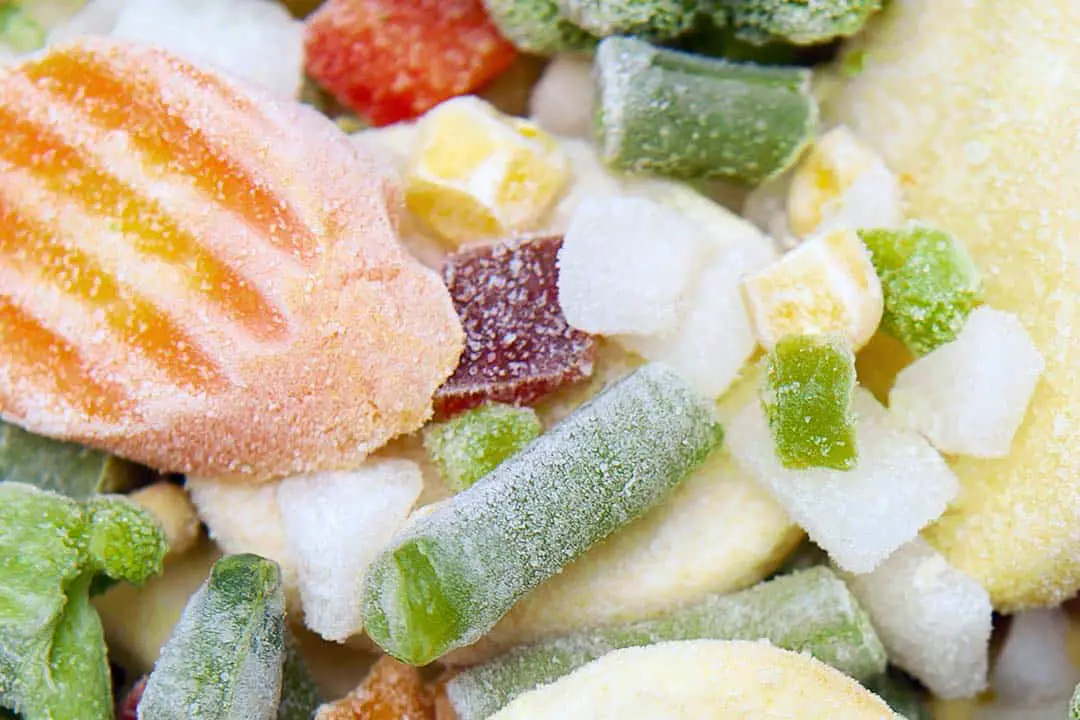Last Updated on 16th September 2022 by
Freezing is one of the most commonly used conventional food preservation methods domestically and in the food industry.
The term “freezing” simply depicts a procedure that lowers food temperature to a level below its freezing point.
Similarly, the word “frozen” refers to the state in which food is held after it has been “thawed,”; when it is maintained below that temperature throughout the rest of the cold chain. (want to know how long water takes to freeze).
Freezing has an extensive history as a well-established and convenient food preservation technique. Moreover, freezing is considered a quick and easy method to enhance food products shelf life significantly.
The key advantages of freezing are long storage life. However, there is the specific quality limitation of freezing, i.e., high water loss/shrinkage, loss of nutrients, physical and chemical damages, low process efficiency, and high energy utilization.
In the last two decades, scientists and researchers significantly improved traditional freezing methods by applying synergistic technologies such as high pressure, infrared irradiation, pulsed electric field, and ultrasound.
What Happens to Food Upon Freezing/Science Behind Freezing
The freezing process changes a food’s physical state by changing water into ice when energy is removed in the form of cooling below freezing temperature (<0°C).
Food is a complex system of various components with diverse compositions; these components have lower freezing points than water.
During the freezing process, cell water inside food will be exposed to extremely low temperatures until it reaches its freezing point. In the meanwhile, the process of ice crystals commences upon water molecules’ separation due to changes in osmotic pressure in the internal parts of the cell.
Ice crystals develop inside the cellular part of food, and the temperature gradually drops. After that, when the crystals cool inside the food, the temperature falls more quickly. Depending on factors like the presence of water, sugar, muscle tissue, or air, each food will freeze differently.
It is crucial to investigate further the water migration process from within the cell. The crystallization process is the large-scale water migration from inside the cell, which ultimately freezes. Many factors influence the formation of ice crystals during the freezing process, including food features such as shape, size, and composition.
Furthermore, freezing rate, temperature, time, heat transfer coefficient, thermal conductivity, and humidity are essential factors of the freezing technique.
Factors Affect Freezing Efficiency
Different factors affect freezing efficiency. The most crucial factor is the freezing rate, as rapid freezing positively influences the food’s quality.
The freezing rate decides the ice crystals’ size, influencing the freezing process. Typically, large ice crystals are developed during slow freezing in the extracellular areas of frozen foods. As a result, these ice crystals induce destructive changes in the food’s microstructure, organoleptic properties and nutrition after thawing.
On the other side, the optimum freezing rate rapidly freezes the food due to small ice crystals formation. Another technical difference is that those tiny crystals do less damage to cell walls than large ice crystals that rupture cell membranes.
In fact, large ice crystals are mainly responsible for causing high drip loss, tissue browning, tissue softening, low water holding capacity and tenderness.
During freezing process, the physicochemical and biochemical reactions of foods slows down, nevertheless does not completely retard these mechanisms responsible for food deterioration. However, sensory/organoleptic quality of food slowly deteriorates with storage, although it takes some time before it becomes unacceptable.
In terms of quality assessment of frozen foods, it might lose over time depending on storage temperature, storage time period, and thawing techniques.
Normally, there is no microbial growth activity at all below –18°C, and enzymatic and nonenzymatic changes continuously appear at a minimal rate.
Physical Changes in Freezing Food Quality
Recrystallization
Ice recrystallization occurs during frozen storage and poses diverse effects on product quality. Ice recrystallization in frozen products is equally critical for quality and shelf life.
If bulk cold stores face temperature fluctuations of 2°C-3°C in average freezing temperature (-18°C), it will not produce detectable damage over a considerable period. However, repeated and significant temperature fluctuations at retail displays and homes stimulate large ice crystals, agglomerate, and migrate to the frozen product surface.
This phenomenon causes toughening of animal tissue and high chances of exposure to available oxygen due to moisture loss.
Protein Denaturation
Freezing causes certain protein denaturation and changes in solubility, although the practical importance of these changes is unknown.
Protein denaturation mainly occurs in fish muscles divided by a unique set of segments known as myotomes.
Freezer Burn
Moisture loss from a food product’s surface during the freeze-thaw cycle results in the dehydration of food products which is known as freezer burn. It is an ugly white or greyish tint that can be mistakenly considered mould.
However, it is disappeared during rehydration or cooking. Freeze burner usually occurs due to improper packaging of food products before freezing.
Conversely, it can be easily controlled by lower storage temperatures, humidification, or improved packaging.
Biochemical Changes in Freezing Food Quality
Rancidity
Oxygen exposure to frozen food products induces oxidative rancidity, colour loss, and off-flavour notes. The freezing process disrupts cell membranes that are exposed to oxidation.
Food products with high unsaturated fats/lipids are highly prone to rancidity due to quick oxidation reactions in the presence of oxygen, such as fish, poultry products, and baked products.
Colour Loss (Enzymatic Browning)
Fruits and vegetables have natural chemical compounds called enzymes. During freezing, these enzymatic reactions can cause colour changes. However, their activity slows down but does not entirely stop during freezing.
To complete inactivation is required to use blanching treatment (Boiling water/steam for a short period) for vegetables. While fruits do not subject to blanching treatment, they can be prevented from enzymatic browning by adding some preservatives like ascorbic acid(vitamin C).
Colour fading in frozen fruits and vegetables is mainly due to exposure to excessive drying caused by poor packaging or prolonged storage. In most cases, freezing does not result in colour changes in poultry. When purchased, bright red meat frequently changes to dark or pale brown during freezing, according to the variety. It happens due to freezer burn or lack of oxygen during freezing.
Foods Unfit for Freezing Preservation
- Highly perishable fruits & vegetables (high water content)
- celery, spinach, tomatoes, lettuce, cucumbers, radishes, melon, watermelon)
- Cooked pasta
- Fried foods
- Soft cheeses
- Creamy dairy products
- yoghurt, dairy desserts, light cream, sour cream
Suitable Food types for Freezing Process
- Fruits & Vegetables
- Dairy Products
- Milk, Butter, Cheese, Egg whites, Whole eggs, Ice cream, & Whipped cream
- Meat, Poultry, and Seafood Products (all types are suitable for freezing)
- Beef, Lamb, Chicken, Bacon, Hot dogs, Sausages, Fish, Prawns, Shrimps, Crab, Lobster
- Bakery Products
- Cookies, Biscuits, Brownies, Cakes (unfrosted), Muffins, Pie, Pizza
- Miscellaneous Products
- Cake Batter, Pizza dough, Yeast dough, Cookie dough

Mahtab Shoukat
Mahtab Shoukat is a Marie Curie Sklodowska Action (MSCA) Early Stage Researcher in INRAE & Université Paris-Saclay Paris France. A young and passionate Food Microbiologist & Microbial Ecologist with a profound background in Food Innovation. He loves disseminating the science behind Food & Nutrition through his write-ups”.

